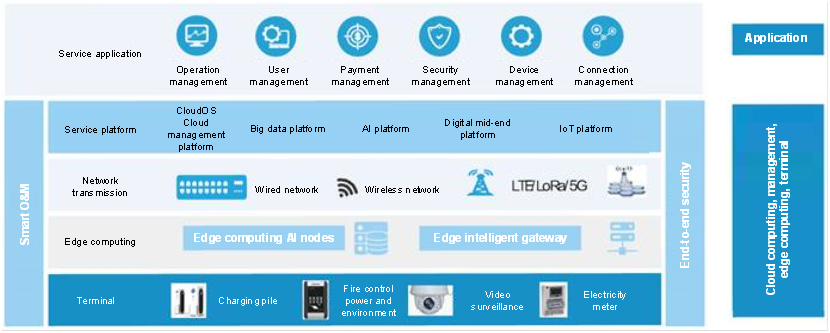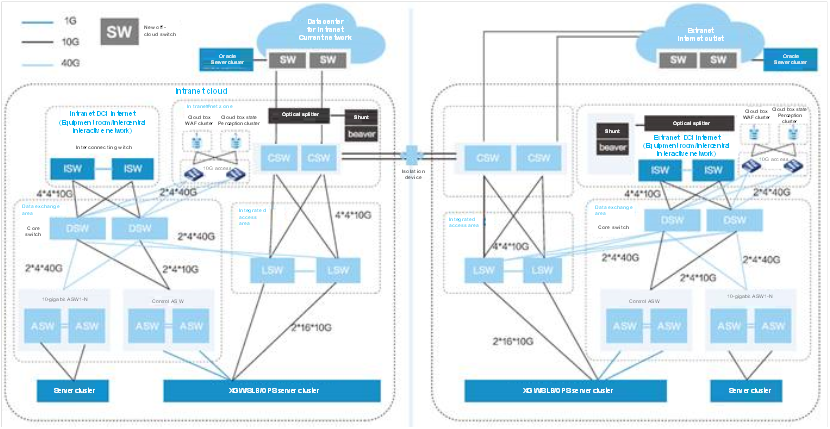New Energy Vehicle Charging Pile Solution
I. Construction background
Developing new energy vehicles is the only road China must take to become an advanced automobile maker from a big automobile maker, and promoting the construction of charging pile infrastructure is a solid guarantee to implement this strategy. In November 2014, the Ministry of Industry and Information Technology of the People's Republic of China issued the Notice on Rewarding Construction of Charging Facilities for New Energy Vehicles. The Notice stipulates that graded subsidies and awards shall be given to local governments that construct charging facilities according to the number of new energy vehicles popularized. In March 2019, the Ministry of Industry and Information Technology of the People's Republic of China issued the Notice on Further Improving the Policy of Fiscal Subsidies Regarding Popularization and Application of New Energy Vehicles. The Notice specifies that "subsidies for procurement of new energy vehicles will be shifted to construction of charging infrastructure" in the future. In March 2020, the central government stipulated that construction of charging piles for new energy vehicles is among the seven major new infrastructures. Therefore, attention and support to construction of charging infrastructure are growing increasingly. In the next decade, the entire market will keep growing at a high speed, and the charging demand for tens of millions of new energy vehicles will create a market worth trillions of RMB.
As one of the seven major new infrastructures, construction of charging piles for new energy vehicles requires a large investment and a long investment chain. Charging piles are of great significance to developing new energy vehicles, and they are also an important part of the emerging digital economy such as intelligent traffic and intelligent energy. The State Grid Corporation of China (SGCC) is taking an active role in the development of new energy vehicles. The SGCC provides services on charging infrastructure construction and grid-connection power supply. With the aim of building a relatively large intelligent IoV platform worldwide, the SGCC has accumulatively connected 457,000 charging piles that cover more than 85% of the public charging piles nationwide. By now, the SGCC has completely built an expressway quick charging network consisting of ten longitudinal lines, ten transverse lines and two loops.
As one of the new infrastructures, charging piles for new energy vehicles are different from the traditional charging piles. The "new" here means new digital technology which is an organic integration between charging piles and communication, cloud computing, intelligent power grid and IoV technology. The construction purpose of the new infrastructures is to use new technologies to increase utilization efficiency. The increase in the usage rate of charging piles will directly increase the profitability of the entire charging pile industry.
Analysis on the sore points of customers:
Mass charging piles - high concurrency access: Faced with data concurrency access of mass charging piles, the operation platform has sore points on status information, location information, environment perception and power consumption information concerning charging piles. How does the operation platform bear the impact of high concurrency, and how does it allocate resources in a flexible way?
Mass charging piles - data analysis and mining: In the future, the operation platform will gather mass data from charging piles. Therefore, how does it fully dig the value of the data to generate additional benefits and to provide users with motive power on business innovation and charging pile operation?
Charging piles - data security cannot be guaranteed: With mass charging pile data, differentiated data collection environments and a complex network transmission environment, it is of great importance for the operation platform to ensure the security of core assets such as application data, pile data and user data.
II. Overview
H3C has been dedicated to the electric power industry for 17 years. Based on an "Intelligent Digital Platform" comprising digital infrastructure, service capability platform, active security and unified O&M, and relying on coordination of cloud computing, management, edge computing and terminal, H3C has provided creative solutions for charging piles of new energy vehicles that are catering to specific user scenarios. The overall solution architecture is as follows:

Cloud: Based on the service characteristic of the new energy system, the cloud computing resource pool is used to realize loose coupling between the IT infrastructure module and the service module, as well as transverse expansion of modularized delivery of the resource pool. The cloud management platform ensures quick delivery and unified management of resources to further facilitate the launch of new services. With a digital platform, the cloud platform can realize collection, storage and analysis of multi-source data in new energy businesses. In this way, it provides upper-layer applications with data support, and provides the SGCC with decision-making basis on distribution transformer load and electric power scheduling.
Management: Based on the complex communication scenarios of charging piles, H3C offers a wired and wireless integrated access solution that supports Wi-Fi, the Ethernet and the RS-485. The solution connects the IoT terminal at the upper layer and connects wired network/4G/5G at the lower layer to ensure real-time communication at all charging pile scenarios. The purpose of the solution is to support high-speed, stable and secure interactions between upper applications and lower terminal data, and to realize access of mass terminal devices and data forwarding.
Terminal: Because charging piles are numerous in type, disperse in deployment and large in quantity, H3C Oasis IoT Platform uses a unified IoT module standard that enables seamless connection between different applications and terminals. In addition, the platform can also shield the difference of underlying vendors and protocols to realize mass connection and high concurrency data processing, as well as more valuable data analysis. With the EPS IoT boundary access system, secure and trustworthy panoramic network management can be realized.
Edge: Faced with mass access terminals, H3C edge computing gateways provide abundant IoT interfaces via expansion. The gateways meet the demand of all charging pile communication scenarios and collect real-time electricity consumption information of charging piles so as to realize information interaction on charging and discharging between the power grid and charging piles, as well as meet the demand on charging service expansion.
Security: Faced with the access of mass charging pile terminals, H3C provides an all-round end-to-end security protection system featuring device security - network security - cloud application security. The system can actively cope with external security attacks to realize access certification for mass terminals, secure transmission for mass data and stable operation for cloud applications.
O&M: The charging pile service system is large in scale and complicated in organization. H3C uses its unified O&M software to provide users with a panoramic O&M solution that helps users extend to service applications upward and cover special charging and transforming devices downward.
III. Highlights
Full stack full scenario cloud: Increasing the overall utilization rate of charging piles via deploying charging operating service on the cloud can effectively solve the problems of constructing IT resources based on peak traffic, which leads to huge waste of resources.
Full stack full scenario AI: By integrating the data analysis engine, the cloud platform and IoT platform, it provides support for data analysis and allows a quick glimpse of the layout of charging piles. This could realize off-peak charging and improve users’ charging experience.
All-round access: Multiple access modes are flexibly combined to realize quick access of charging devices and high-speed transmission of data.
All-round security: Building a multi-azimuth security protection system and providing end-to-end security protection at the device layer side and the application side to realize secure access of mass terminals and secure access of data.
Full scenario O&M: The establishment of the integrated O&M system realizes intelligent O&M for charging device monitors and service applications. The system breaks the barrier of the isolated island of information and achieves digital transformation of O&M.
IV. Typical cases
The electric vehicle IoT service platform is a core carrier for the State Grid EV Service Co., Ltd. to carry out "IoT + charging service", "Internet + travel service" and "big data + value added service". By using the "big data + cloud computing + IoT + mobile Internet + intelligent city" technology, State Grid EV Service Co., Ltd. builds a private cloud platform of elastic resource supply, flexible scheduling and dynamic metering which meets the requirement of multiple users. By following the idea of "big platform + microservice", H3C manages to deploy IoV platform services in a cloud computing environment by cloud reconstruction. H3C builds multiple application service development oriented public capability centers, and multiple application clusters and capability open platforms regarding charging service, travel service, value added service and data service to meet the requirement of accessing mass charging terminals and to provide mass users with charging service. H3C wins the bidding for the infrastructure construction project of IoV service platform of State Grid EV Service Co., Ltd. to provide an underlying infrastructure for the IoV service platform.
Requirement analysis
Ø The platform cannot support high concurrent access
The IoV platform involves concurrent access of mass data, including charging pile status information, location information, environment perception, electricity consumption information and driver-vehicle behavior data. The load of the IoV platform increases with the growth of service development, making it difficult to bear the impact of high concurrency.
Ø Value mining for mass data is difficult.
The IoV gathers mass data but lacks effective means to fully mine the value of data. Therefore, data mining can help enterprises promote service innovation and operating efficiency.
Ø Data security of charging piles cannot be guaranteed.
Faced with mass charging pile data, differentiated data collection environments and a complex network transmission environment, it is of great importance for the operation platform to ensure the security of core assets such as application data, pile data and user data.
Overview
H3C provides the EV IoT service platform with construction for laaS layer of network fundamentals. The construction involves dozens of data center switches and high-performance servers that meet the requirement for IoT mid-end platform and data mid-end platform construction. This empowers future EV service mid-end platforms with unified cloud fundamental service capability that is flexible and scalable.

V. Customer’s value
Through the construction of the laaS layer for the IoT service platform, software and hardware resources on the platform are effectively integrated and flexibly used to further support charging pile construction of the State Grid EV Service Co., Ltd. Building laaS layer network and computing resource pool can reduce the overall IT ownership cost and operation cost, make O&M convenient, lower the energy consumption of the equipment room, greatly increase the utilization ratio of resources, increase the flexibility on deployment of software and hardware resources to realize elastic expansion of resources according to the demand.


